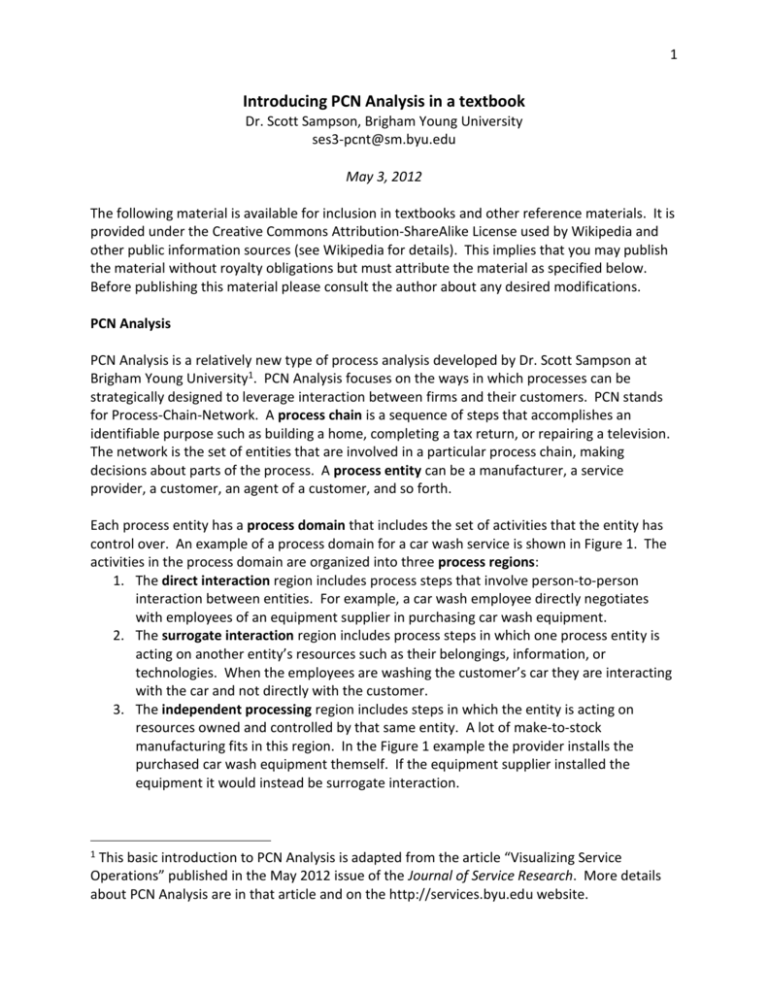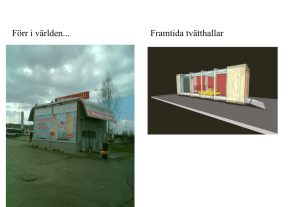PCN Analysis: Process-Chain-Network Introduction
advertisement

1 Introducing PCN Analysis in a textbook Dr. Scott Sampson, Brigham Young University ses3-pcnt@sm.byu.edu May 3, 2012 The following material is available for inclusion in textbooks and other reference materials. It is provided under the Creative Commons Attribution-ShareAlike License used by Wikipedia and other public information sources (see Wikipedia for details). This implies that you may publish the material without royalty obligations but must attribute the material as specified below. Before publishing this material please consult the author about any desired modifications. PCN Analysis PCN Analysis is a relatively new type of process analysis developed by Dr. Scott Sampson at Brigham Young University1. PCN Analysis focuses on the ways in which processes can be strategically designed to leverage interaction between firms and their customers. PCN stands for Process-Chain-Network. A process chain is a sequence of steps that accomplishes an identifiable purpose such as building a home, completing a tax return, or repairing a television. The network is the set of entities that are involved in a particular process chain, making decisions about parts of the process. A process entity can be a manufacturer, a service provider, a customer, an agent of a customer, and so forth. Each process entity has a process domain that includes the set of activities that the entity has control over. An example of a process domain for a car wash service is shown in Figure 1. The activities in the process domain are organized into three process regions: 1. The direct interaction region includes process steps that involve person-to-person interaction between entities. For example, a car wash employee directly negotiates with employees of an equipment supplier in purchasing car wash equipment. 2. The surrogate interaction region includes process steps in which one process entity is acting on another entity’s resources such as their belongings, information, or technologies. When the employees are washing the customer’s car they are interacting with the car and not directly with the customer. 3. The independent processing region includes steps in which the entity is acting on resources owned and controlled by that same entity. A lot of make-to-stock manufacturing fits in this region. In the Figure 1 example the provider installs the purchased car wash equipment themself. If the equipment supplier installed the equipment it would instead be surrogate interaction. 1 This basic introduction to PCN Analysis is adapted from the article “Visualizing Service Operations” published in the May 2012 issue of the Journal of Service Research. More details about PCN Analysis are in that article and on the http://services.byu.edu website. 2 There are important operational distinctions between these three categories of process steps. Process entities have more control over independent processing steps than they do over surrogate or direct interactive steps, due to the need to give up some control in order to interact. The slanted “roof” on a PCN Diagram reminds us of those different levels of control. Service operations exist within the regions of direct and surrogate interaction. Service operations are more personal than independent processing operations due to the interaction between providers and customers. Independent processing such as mass-production manufacturing can be tightly controlled by the manufacturer, can be located near low-cost labor and natural resources, can give employees tightly defined job descriptions, can organize the manufacturing facilities for maximum efficiency, and so forth. On the other hand, direct interaction such as health care delivery cedes some control to the customers, should locate facilities somewhat convenient to customers, provides employees with more flexible job descriptions that allow responsiveness to varying customer needs, organizes facilities to accommodate customer needs and expectations, and so forth. All three process regions have similar operating issues—process control, facility location, job design, facility layout, etc.—but the appropriate way of handling the issues differs across regions. Since PCN Analysis considers networks of entities, it is more interesting to consider PCN Diagrams involving more than one entity, such as shown in Figure 2. There, the car wash provider is on the left and the customer is on the right, with only the adjacent regions of interaction being depicted. An important feature of PCN Analysis is not only understanding the provider firms’ operations, but also understanding relevant customer operations that are part of the same process chain. In the Figure 2 example the customer independently identifies the need for having his or her car washed. The customer might check prices on the car wash firm’s website, which is surrogate interaction with the car wash firm. In this example the customers may independently choose to use the car wash firm or “do it yourself” (DIY) at home. DIY might be less expensive on a variable cost basis (for each washing of the car), but may be more expensive if doing the car wash requires specialized equipment and skills (which represent fixed costs). The car wash provider has specialized equipment and skills that they use for many customers, thus providing economies of scale. The quality of the car wash may depend on how much the specialized car wash equipment and skills are needed—if they are essential then the provider could probably provide a higher quality car wash, but if they are not essential then the customer could possibly provide a higher quality car wash. One valuable aspect of PCN Analysis is strategic process positioning wherein a process is designed to achieve strategic operating objectives. A firm’s operations are strategic in that they can define what type of business the firm is in and what value proposition they desire to provide to customers. For example, some firms assume a low-cost strategy and some firms assume a differentiation strategy. The operational strategy of a firm can be depicted in the process regions of a PCN Diagram. 3 Figure 3 shows various options for the “wash car” step. The first option is for the provider to wash cars before delivering them to customers, which is what rental car firms usually do. The next option has the provider wash the customer’s car without directly interacting for that step. Washing a car through direct interaction seems unusual, but is a strategic option. Self-serve car washes allow customers to use the specialized equipment of providers but also takes control of the process step. The right-most option is for the customers to wash their cars just using resources they own, as was suggested in the DIY option from Figure 2. Figure 3 also depicts some major strategic implications of process positioning. If the firm wants to achieve high economies of scale in their operations they should probably position the step towards the independent processing region of their process domain. One way to achieve this is to not wash cars directly but instead manufacture car wash kits that can be sold to customers for their DIY use. If the firm’s intended value offering focuses on customization then the step should be positioned more towards the customers’ process domain. Note that a DIY option can achieve maximum customization since the customer can do almost anything to perform the car wash step, including things that are unusual such as using pickle juice to clean grime off of hubcaps. PCN Analysis has been applied in a wide variety of business settings with tremendous results. This section introduced basic PCN Analysis. More advanced analysis assesses the value proposition of an operation including costs and benefits, considers the design of an operating environment, demonstrates how process chains can be coordinated across a broad network of entities, and more. More information is available from the http://services.byu.edu website. 4 End-of-chapter material: Student exercise 1. Draw a two-entity PCN Diagram (like Figure 2) for one of the following processes and be prepared to discuss it in class: a. the process of having your computer repaired b. the process of having a dental exam c. the process of take-out pizza d. the process of attending a concert 2. Review strategic process positioning options for the following steps in Figure 2, discussing the operational impact of repositioning the process step: a. drive to car wash (e.g., could the firm come to the customer?) b. review options (i.e., car wash options provided by the firm) c. process payment 3. Select a service business relating to your major that involves interaction between customers and service providers, and create a PCN Diagram similar to Figure 2. Pick a key step that could be performed either by the service provider or by the customers. Show process positioning options for the step. Describe how the options compare in terms of efficiency, economies of scale, and opportunity for customization. Glossary process chain: a sequence of steps that accomplishes an identifiable purpose (of providing value to process entities). process entity: an individual or organization that participates in a process chain, making decisions about one or more process steps. process domain: a set of process steps that a process entity has decision control over. process region: a portion of steps within a process domain. direct interaction region: process steps that involve person-to-person interaction between entities. surrogate interaction region: process steps that involve interaction between entities that is not person-to-person. independent processing region: process steps where an entity only acts on their own resources. strategic process positioning: changing the process region of one or more process steps in order to achieve strategic operating objectives.






